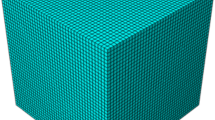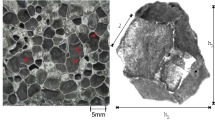Abstract
Open cell metal foams can be represented by a network of beams. Due to the heterogeneity of the geometry, the length scale of the representative volume element is often nearly of the same order as the length scale of structures made of metal foam. Therefore, classical homogenization techniques for the computation of effective properties can not be applied. Statistical volume elements lead to apparent material properties that depend on the boundary conditions. Here, we introduce a model for structures made of metal foam that consists of two domains, an interior region and a boundary region. For both regions, unique random fields are identified by simulations of the microstructure. The model is validated by comparison with Finite Element simulations and experiments.
Access this chapter
Tax calculation will be finalised at checkout
Purchases are for personal use only
Similar content being viewed by others
References
Aurenhammer F (1987) Power diagrams: properties, algorithms and applications. SIAM J Comput 16:78–96
Di Paola F (2011) Modélisation multi-échelles du comportement thermo-élastique de composites à particules sphériques. Dissertation, Ecole Centrale de Paris
Dirrenberger J, Forest S, Jeulin D (2014) Towards gigantic RVE sizes for 3D stochastic fibrous networks. Solids Struct 51:359–376
Drugan WJ, Willis JR (1996) A micromechanics-based nonlocal constitutive equation and estimates of representative volume element size for elastic composites. J Mech Phys Solids 44(4):497–524
Fraunhofer ITWM, Department Image Processing (Hrsg.) (2006) MAVI – modular algorithms for volume images. Department Image Processing, Fraunhofer ITWM, Kaiserslautern. http://www.mavi-3d.de
Gibson LJ, Ashby MF (1997) Cellular solids – structure and properties. Cambridge University Press, Cambridge
Guilleminot J, Noshadravan A, Soize C, Ghanem RG (2011) A probabilistic model for bounded elasticity tensor random fields with application to polycristalline microstructures. Comput Methods Appl Mech Eng 200:1637–1648
Hardenacke V, Hohe J (2009) Local probabilistic homogenization of two-dimensional model foams accounting for micro structural disorder. Int J Solids Struct 46:989–1006
Hardenacke V, Hohe J (2010) Assessment of space division strategies for generation of adequate computational models for solid foams. Int J Mech Sci 52:1772–1782
Hazanov S, Huet C (1994) Order relationships for boundary conditions effect in heterogeneous bodies smaller than the representative volume. J Mech Phys Solids 42(12):1995–2011
Huet C (1990) Application of variational concepts to size effects in elastic heterogeneous bodies. J Mech Phys Solids 38(6):813–841
Kanaun S, Tkachenko O (2007) Representative volume element and effective elastic properties of open cell foam materials with random microstructues. J Mech Mater Struct 2(6):1607–1628
Kanaun S, Tkachenko O (2008) Effective conductive properties of open-cell foams. Int J Eng Sci 46:551–571
Kanit T, Forest S, Galliet I, Mounoury V, Jeulin D (2003) Determination of the size of the representative volume element for random composites: statistical and numerical approach. Int J Solids Struct 40:3647–3679
Lautensack C (2008) Fitting three-dimensional Laguerre tessellations to foam structures. J Appl Stat 35(9):985–995
Liebscher A, Redenbach C (2013) Statistical analysis of the local strut thickness of open cell foams. Image Anal Stereol. Accepted for publication 32:1–12
Liebscher A, Proppe C, Redenbach C, Schwarzer D (2012) Uncertainty quantification for metal foam structures by means of digital image based analysis. Probab Eng Mech 28:143–152
Ohser J, Schladitz K (2009) 3D images of materials structures – processing and analysis. Wiley, Heidelberg
Ostoja-Starzewski M (2007) Microstructural randomness and scaling in mechanics of materials. Chapman & Hall/CRC, Boca Raton
Ostoja-Starzewski M (2011) Stochastic finite elements: where is the physics? Theor Appl Mech 38:379–396
Phoon KK, Huang SP, Quek ST (2005) Simulation of strongly non-Gaussian processes using Karhunen-Loève expansion. Probab Eng Mech 20:188–198
Redenbach C (2009) Microstructure models for cellular materials. Comput Mater Sci 44:1397–1407
Soille P (1999) Morphological image analysis. Springer, Berlin
Stoyan D, Kendall, WS, Mecke J (1995) Stochastic geometry and its applications, 2nd edn. Wiley, Chichester
Zhu HX, Hobdell JR, Windle AH (2000) Effects of cell irregularity on the elastic properties of open-cell foams. Acta Mater 48(20):4893–4900
Acknowledgements
This work was supported in part by the German Research Foundation (DFG) under grants RE 3002/1-1 and PR 1114/10-1.
Author information
Authors and Affiliations
Corresponding author
Editor information
Editors and Affiliations
Rights and permissions
Copyright information
© 2014 Springer International Publishing Switzerland
About this paper
Cite this paper
Geißendörfer, M., Liebscher, A., Proppe, C., Redenbach, C., Schwarzer, D. (2014). Statistical Volume Elements for Metal Foams. In: Papadrakakis, M., Stefanou, G. (eds) Multiscale Modeling and Uncertainty Quantification of Materials and Structures. Springer, Cham. https://doi.org/10.1007/978-3-319-06331-7_11
Download citation
DOI: https://doi.org/10.1007/978-3-319-06331-7_11
Published:
Publisher Name: Springer, Cham
Print ISBN: 978-3-319-06330-0
Online ISBN: 978-3-319-06331-7
eBook Packages: EngineeringEngineering (R0)




